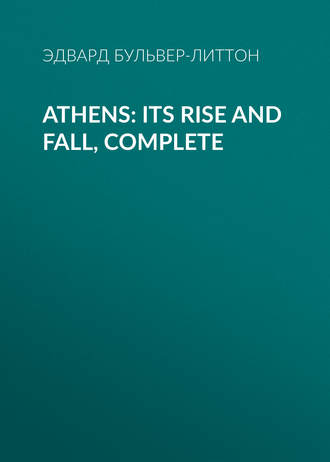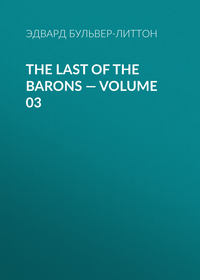 полная версия
полная версияAthens: Its Rise and Fall, Complete
But a storm on the stage, instead of exceeding, so poorly mimics the reality, that it can never realize the effect which the poet designs, and with which the reader is impressed. So is it with supernatural and fanciful creations, especially of the more delicate and subtle kind. The Ariel of the “Tempest,” the fairies of the “Midsummer Night’s Dream,” and the Oceanides of the “Prometheus,” are not to be represented by human shapes. We cannot say that they are not dramatic, but they are not theatrical. We can sympathize with the poet, but not with the actor. For the same reason, in a lesser degree, all creations, even of human character, that very highly task the imagination, that lift the reader wholly out of actual experience, and above the common earth, are comparatively feeble when reduced to visible forms. The most metaphysical plays of Shakspeare are the least popular in representation. Thus the very genius of Aeschylus, that kindles us in the closet, must often have militated against him on the stage. But in Sophocles all—even the divinities themselves— are touched with humanity; they are not too subtle or too lofty to be submitted to mortal gaze. We feel at once that on the stage Sophocles ought to have won the prize from Aeschylus; and, as a proof of this, if we look at the plays of each, we see that scarcely any of the great characters of Aeschylus could have called into sufficient exercise the powers of an actor. Prometheus on his rock, never changing even his position, never absent from the scene, is denied all the relief, the play and mobility, that an actor needs. His earthly representative could be but a grand reciter. In the “Persians,” not only the theatrical, but the dramatic effect is wanting—it is splendid poetry put into various mouths, but there is no collision of passions, no surprise, no incident, no plot, no rapid dialogue in which words are but the types of emotions. In the “Suppliants” Garrick could have made nothing of Pelasgus. In the “Seven before Thebes” there are not above twenty or thirty lines in the part of Eteocles in which the art of the actor could greatly assist the genius of the poet. In the’ trilogy of the “Agamemnon,” the “Choephori,” and the “Orestes,” written in advanced years, we may trace the contagious innovation of Sophocles; but still, even in these tragedies, there is no part so effective in representation as those afforded by the great characters of Sophocles. In the first play the hypocrisy and power of Clytemnestra would, it is true, have partially required and elicited the talents of the player; but Agamemnon himself is but a thing of pageant, and the splendid bursts of Cassandra might have been effectively uttered by a very inferior histrionic artist. In the second play, in the scene between Orestes and his mother, and in the gathering madness of Orestes, the art of the poet would unquestionably task to the uttermost the skill of the performer. But in the last play (the Furies), perhaps the sublimest poem of the three, which opens so grandly with the parricide at the sanctuary, and the Furies sleeping around him, there is not one scene from the beginning to the end in which an eminent actor could exhibit his genius.
But when we come to the plays of Sophocles, we feel that a new era in the drama is created; we feel that the artist poet has called into full existence the artist actor. His theatrical effects 375 are tangible, actual—could be represented to-morrow in Paris—in London— everywhere. We find, therefore, that with Sophocles has passed down to posterity the name of the great actor 376 in his principal plays. And I think the English reader, even in the general analysis and occasional translations with which I have ventured to fill so many pages, will perceive that all the exertions of subtle, delicate, and passionate power, even in a modern actor, would be absolutely requisite to do justice to the characters of Oedipus at Coloneus, Antigone, Electra, and Philoctetes.
This, then, was the distinction between Aeschylus and Sophocles—both were artists, as genius always must be, but the art of the latter adapts itself better to representation. And this distinction in art was not caused merely by precedence in time. Had Aeschylus followed Sophocles, it would equally have existed—it was the natural consequence of the distinctions in their genius—the one more sublime, the other more impassioned—the one exalting the imagination, the other appealing to the heart. Aeschylus is the Michael Angelo of the drama, Sophocles the Raffaele.
XIII. Thus have I presented to the general reader the outline of all the tragedies of Sophocles. In the great length at which I have entered in this, not the least difficult, part of my general task, I have widely innovated on the plan pursued by the writers of Grecian history. For this innovation I offer no excuse. It is her poetry at the period we now examine, as her philosophy in a later time, that makes the individuality of Athens. In Sophocles we behold the age of Pericles. The wars of that brilliant day were as pastimes to the mighty carnage of oriental or northern battle. The reduction of a single town, which, in our time, that has no Sophocles and no Pericles, a captain of artillery would demolish in a week, was the proudest exploit of the Olympian of the Agora; a little while, and one defeat wrests the diadem of the seas from the brows of “The Violet Queen;” scanty indeed the ruins that attest the glories of “The Propylaea, the Parthenon, the Porticoes, and the Docks,” to which the eloquent orator appealed as the “indestructible possessions” of Athens; along the desolate site of the once tumultuous Agora the peasant drives his oxen—the champion deity 377 of Phidias, whose spectral apparition daunted the barbarian Alaric 378, and the gleam of whose spear gladdened the mariner beneath the heights of Sunium, has vanished from the Acropolis; but, happily, the age of Pericles has its stamp and effigy in an art more imperishable than that of war—in materials more durable than those of bronze and marble, of ivory and gold. In the majestic harmony, the symmetrical grace of Sophocles, we survey the true portraiture of the genius of the times, and the old man of Coloneus still celebrates the name of Athens in a sweeter song than that of the nightingale 379, and melodies that have survived the muses of Cephisus 380. Sophocles was allegorically the prophet when he declared that in the grave of Oedipus was to be found the sacred guardian and the everlasting defence of the city of Theseus.
FOOTNOTES
1 (return)
[ In their passage through the press I have, however, had many opportunities to consult and refer to Mr. Thirlwall’s able and careful work.
2 (return)
[ The passage in Aristotle (Meteorol., l. I, c. 14), in which, speaking of the ancient Hellas (the country about Dodona and the river Achelous), the author says it was inhabited by a people (along with the Helli, or Selli) then called Graeci, now Hellenes (tote men Graikoi, nun de Hellaenes) is well known. The Greek chronicle on the Arundel marbles asserts, that the Greeks were called Graeci before they were called Hellenes; in fact, Graeci was most probably once a name for the Pelasgi, or for a powerful, perhaps predominant, tribe of the Pelasgi widely extended along the western coast—by them the name was borne into Italy, and (used indiscriminately with that of Pelasgi) gave the Latin appellation to the Hellenic or Grecian people.
3 (return)
[ Modern travellers, in their eloquent lamentations over the now niggard waters of these immortal streams, appear to forget that Strabo expressly informs us that the Cephisus flowed in the manner of a torrent, and failed altogether in the summer. “Much the same,” he adds, “was the Ilissus.” A deficiency of water was always a principal grievance in Attica, as we may learn from the laws of Solon relative to wells.
4 (return)
[ Platon. Timaeus. Clinton’s Fasti Hellenici, vol. i., p. 5.
5
[ According to some they were from India, to others from Egypt, to others again from Phoenicia. They have been systematized into Bactrians, and Scythians, and Philistines—into Goths, and into Celts; and tracked by investigations as ingenious as they are futile, beyond the banks of the Danube to their settlements in the Peloponnese. No erudition and no speculation can, however, succeed in proving their existence in any part of the world prior to their appearance in Greece.
6 (return)
[ Sophoc. Ajax, 1251.
7 (return)
[ All those words (in the Latin) which make the foundation of a language, expressive of the wants or simple relations of life, are almost literally Greek—such as pater, frater, aratrum, bos, ager, etc. For the derivation of the Latin from the Aeolic dialect of Greece, see “Scheid’s Prolegomena to Lennep’s Etymologicon Linguae Grecae.”
8 (return)
[ The Leleges, Dryopes, and most of the other hordes prevalent in Greece, with the Pelasgi, I consider, with Mr. Clinton, but as tribes belonging to the great Pelasgic family. One tribe would evidently become more civilized than the rest, in proportion to the social state of the lands through which it migrated—its reception of strangers from the more advanced East—or according as the circumstances of the soil in which it fixed its abode stimulated it to industry, or forced it to invention. The tradition relative to Pelasgus, that while it asserts him to have been the first that dwelt in Arcadia, declares also that he first taught men to build huts, wear garments of skins, and exchange the yet less nutritious food of herbs and roots for the sweet and palatable acorns of the “fagus,” justly puzzled Pausanias. Such traditions, if they prove any thing, which I more than doubt, tend to prove that the tribe personified by the word “Pelasgus,” migrated into that very Arcadia alleged to have been their aboriginal home, and taught their own rude arts to the yet less cultivated population they found there.
9 (return)
[ See Isaiah xxiii.
10 (return)
[ The received account of the agricultural skill of the Pelasgi is tolerably well supported. Dionysius tells us that the Aboriginals having assigned to those Pelasgi, whom the oracle sent from Dodona into Italy, the marshy and unprofitable land called Velia, they soon drained the fen:—their love of husbandry contributed, no doubt, to form the peculiar character of their civilization and religion.
11 (return)
[ Solinus and Pliny state that the Pelasgi first brought letters into Italy. Long the leading race of Italy, their power declined, according to Dionysius, two generations before the Trojan war.
12 (return)
[ Paus. Arcad., c. xxxviii. In a previous chapter (II.) that accomplished antiquary observes, that it appeared to him that Cecrops and Lycaon (son of Pelasgus and founder of Lycosura) were contemporaries. By the strong and exaggerating expression of Pausanias quoted in the text, we must suppose, not that he considered Lycosura the first town of the earth, but the first walled and fortified city. The sons of Lycaon were great builders of cities, and in their time rapid strides in civilization appear by tradition to have been made in the Peloponnesus. The Pelasgic architecture is often confounded with the Cyclopean. The Pelasgic masonry is polygonal, each stone fitting into the other without cement; that called the Cyclopean, and described by Pausanias, is utterly different, being composed by immense blocks of stone, with small pebbles inserted in the interstices. (See Gell’s Topography of Rome and its Vicinity.) By some antiquaries, who have not made the mistake of confounding these distinct orders of architecture, the Cyclopean has been deemed more ancient than the Pelasgic,—but this also is an error. Lycosura was walled by the Pelasgians between four and five centuries prior to the introduction of the Cyclopean masonry—in the building of the city of Tiryns. Sir William Gell maintains the possibility of tracing the walls of Lycosura near the place now called Surias To Kastro.
13 (return)
[ The expulsion of the Hyksos, which was not accomplished by one sudden, but by repeated revolutions, caused many migrations; among others, according to the Egyptians, that of Danaus.
14 (return)
[ The Egyptian monarchs, in a later age, employed the Phoenicians in long and adventurous maritime undertakings. At a comparatively recent date, Neco, king of Egypt, despatched certain Phoenicians on no less an enterprise than that of the circumnavigation of Africa. [Footnote Herod., iv., 12. Rennell., Geog. of Herod.: That monarch was indeed fitted for great designs. The Mediterranean and the Red Sea already received his fleets, and he had attempted to unite them by a canal which would have rendered Africa an island. [Footnote Herod., ii., 158, 159. Heeren., Phoenicians, c. iii. See also Diodorus.:
15 (return)
[ The general habits of a people can in no age preclude exceptions in individuals. Indian rajahs do not usually travel, but we had an Indian rajah for some years in the Regent’s Park; the Chinese are not in the habit of visiting England, but a short time ago some Chinese were in London. Grant that Phoenicians had intercourse with Egypt and with Greece, and nothing can be less improbable than that a Phoenician vessel may have contained some Egyptian adventurers. They might certainly be men of low rank and desperate fortunes—they might be fugitives from the law—but they might not the less have seemed princes and sages to a horde of Pelasgic savages.
16 (return)
[ The authorities in favour of the Egyptian origin of Cecrops are.—Diod., lib. i.; Theopomp.; Schol. Aristoph.; Plot.; Suidas. Plato speaks of the ancient connexion between Sais and Athens. Solon finds the names of Erechtheus and Cecrops in Egypt, according to the same authority, I grant a doubtful one (Plat. Critias.) The best positive authority of which I am aware in favour of the contrary supposition that Cecrops was indigenous, is Apollodorus.
17 (return)
[ To enter into all the arguments that have been urged on either side relative to Cecrops would occupy about two hundred pages of this work, and still leave the question in dispute. Perhaps two hundred pages might be devoted to subjects more generally instructive.
18 (return)
[ So, in the Peruvian traditions, the apparition of two persons of majestic form and graceful garments, appearing alone and unarmed on the margin of the Lake Titiaca, sufficed to reclaim a naked and wretched horde from their savage life, to inculcate the elements of the social union, and to collect a people in establishing a throne.
19 (return)
[ “Like the Greeks,” says Herodotus (book ii., c. 112), “the Egyptians confine themselves to one wife.” Latterly, this among the Greeks, though a common, was not an invariable, restraint; but more on this hereafter.
20 (return)
[ Hobhouse’s Travels, Letter 23.
21 (return)
[ It is by no means probable that this city, despite its fortress, was walled like Lycosura.
22 (return)
[ At least Strabo assigns Boeotia to the government of Cecrops. But I confess, that so far from his incorporating Boeotia with Attica, I think that traditions relative to his immediate successors appear to indicate that Attica itself continued to retain independent tribes— soon ripening, if not already advanced, to independent states.
23 (return)
[ Herod., ii., c. i.
24 (return)
[ Ibid., ii., c. liii.
25 (return)
[ That all the Pelasgi—scattered throughout Greece, divided among themselves—frequently at war with each other, and certainly in no habits of peaceful communication—each tribe of different modes of life, and different degrees of civilization, should have concurred in giving no names to their gods, and then have equally concurred in receiving names from Egypt, is an assertion so preposterous, that it carries with it its own contradiction. Many of the mistakes relative to the Pelasgi appear to have arisen from supposing the common name implied a common and united tribe, and not a vast and dispersed people, subdivided into innumerable families, and diversified by innumerable influences.
26 (return)
[ The connexion of Ceres with Isis was a subsequent innovation.
27 (return)
[ Orcos was the personification of an oath, or the sanctity of an oath.
28 (return)
[ Naith in the Doric dialect.
29 (return)
[ If Onca, or Onga, was the name of the Phoenician goddess!—In the “Seven against Thebes,” the chorus invoke Minerva under the name of Onca—and there can be no doubt that the Grecian Minerva is sometimes called Onca; but it is not clear to me that the Phoenicians had a deity of that name—nor can I agree with those who insist upon reading Onca for Siga in Pausanias (lib. ix., chap. 12), where he says Siga was the name of the Phoenician Minerva. The Phoenicians evidently had a deity correspondent with the Greek Minerva; but that it was named Onca, or Onga, is by no means satisfactorily proved; and the Scholiast, on Pindar, derives the epithet as applies to Minerva from a Boeotian village.
30 (return)
[ De Mundo, c. 7.
31 (return)
[ The Egyptians supposed three principles: 1st. One benevolent and universal Spirit. 2d. Matter coeval with eternity. 3d. Nature opposing the good of the universal Spirit. We find these principles in a variety of shapes typified through their deities. Besides their types of nature, as the Egyptians adopted hero gods, typical fables were invented to conceal their humanity, to excuse their errors, or to dignify their achievements.
32 (return)
[ See Heeren’s Political History of Greece, in which this point is luminously argued.
33 (return)
[ Besides, it is not the character of emigrants from a people accustomed to castes, to propagate those castes superior to then own, of which they have exported no representatives. Suppose none of that privileged and noble order, called the priests, to have accompanied the Egyptian migrators, those migrators would never have dreamed of instituting that order in their new settlement any more than a colony of the warrior caste in India would establish out of their own order a spurious and fictitious caste of Bramins.
34 (return)
[ When, in a later age, Karmath, the impostor of the East, sough to undermine Mahometanism, his most successful policy was in declaring its commands to be allegories.
35 (return)
[ Herodotus (b. ii, c. 53) observes, that it is to Hesiod and Homer the Greeks owe their theogony; that they gave the gods their titles, fixed their ranks, and described their shapes. And although this cannot be believed literally, in some respects it may metaphorically. Doubtless the poets took their descriptions from popular traditions; but they made those traditions immortal. Jupiter could never become symbolical to a people who had once pictured to themselves the nod and curls of the Jupiter of Homer.
36 (return)
[ Cicero de Natura Deorum, b. ii.—Most of the philosophical interpretations of the Greek mythology were the offspring of the Alexandrine schools. It is to the honour of Aristarchus that he combated a theory that very much resembles the philosophy that would convert the youthful readers of Mother Bunch into the inventors of allegorical morality.
37 (return)
[ But the worship can be traced to a much earlier date than that the most plausibly ascribed to the Persian Zoroaster.
38 (return)
[ So Epimenides of Crete is said to have spent forty-five years in a cavern, and Minos descends into the sacred cave of Jupiter to receive from him the elements of law. The awe attached to woods and caverns, it may be observed, is to be found in the Northern as well as Eastern superstitions. And there is scarcely a nation on the earth in which we do not find the ancient superstition has especially attached itself to the cavern and the forest, peopling them with peculiar demons. Darkness, silence, and solitude are priests that eternally speak to the senses; and few of the most skeptical of us have been lost in thick woods, or entered lonely caverns, without acknowledging their influence upon the imagination: “Ipsa silentia,” says beautifully the elder Pliny, “ipsa silentia adoramus.” The effect of streams and fountains upon the mind seems more unusual and surprising. Yet, to a people unacquainted with physics, waters imbued with mineral properties, or exhaling mephitic vapours, may well appear possessed of a something preternatural. Accordingly, at this day, among many savage tribes we find that such springs are regarded with veneration and awe. The people of Fiji, in the South Seas, have a well which they imagine the passage to the next world, they even believe that you may see in its waters the spectral images of things rolling on to eternity. Fountains no less than groves, were objects of veneration with our Saxon ancestors.—See Meginhard, Wilkins, etc.
39 (return)
[ 2 Kings xvi., 4.
40 (return)
[ Of the three graces, Aglaia, Euphrosyne, and Thalia, the Spartans originally worshipped but one—(Aglaia, splendour) under the name of Phaenna, brightness: they rejected the other two, whose names signify Joy and Pleasure, and adopted a substitute in one whose name was Sound (Cletha,)—a very common substitute nowadays!
41 (return)
[ The Persian creed, derived from Zoroaster, resembled the most to that of Christianity. It inculcated the resurrection of the dead, the universal triumph of Ormuzd, the Principle of Light—the destruction of the reign of Ahrimanes, the Evil Principle.
42 (return)
[ Wherever Egyptian, or indeed Grecian colonies migrated, nothing was more natural than that, where they found a coincidence of scene, they should establish a coincidence of name. In Epirus were also the Acheron and Cocytus; and Campania contains the whole topography of the Virgilian Hades.
43 (return)
[ See sect. xxi., p. 77.
44 (return)
[ Fire was everywhere in the East a sacred symbol—though it cannot be implicitly believed that the Vulcan or Hephaistus of the Greeks has his prototype or original in the Egyptian Phta or Phtas. The Persian philosophy made fire a symbol of the Divine intelligence— the Persian credulity, like the Grecian, converted the symbol into the god (Max. Tyr., Dissert. 38; Herod., lib. 3, c. 16). The Jews themselves connected the element with their true Deity. It is in fire that Jehovah reveals himself. A sacred flame was burnt unceasingly in the temples of Israel, and grave the punishment attached to the neglect which suffered its extinction.—(Maimonides, Tract. vi.)
45 (return)
[ The Anaglyph expressed the secret writings of the Egyptians, known only to the priests. The hieroglyph was known generally to the educated.
46 (return)
[ In Gaul, Cesar finds some tribes more civilized than the rest, cultivating the science of sacrifice, and possessed of the dark philosophy of superstitious mysteries; but in certain other and more uncivilized tribes only the elements and the heavenly luminaries (quos cernunt et quorum opibus aperte juvantur) were worshipped, and the lore of sacrifice was unstudied. With the Pelasgi as with the Gauls, I believe that such distinctions might have been found simultaneously in different tribes.
47 (return)
[ The arrival of Ceres in Attica is referred to the time of Pandion by Apollodorus.
48 (return)
[ When Lobeck desires to fix the date of this religious union at so recent an epoch as the time of Solon, in consequence of a solitary passage in Herodotus, in which Solon, conversing with Croesus, speaks of hostilities between the Athenians and Eleusinians, he seems to me to fail in sufficient ground for the assumption. The rite might have been instituted in consequence of a far earlier feud and league—even that traditionally recorded in the Mythic age of Erechtheus and Eumolpus, but could not entirely put an end to the struggles of Eleusis for independence, or prevent the outbreak of occasional jealousy and dissension.
49 (return)
[ Kneph, the Agatho demon, or Good Spirit of Egypt, had his symbol in the serpent. It was precisely because sacred with the rest of the world that the serpent would be an object of abhorrence with the Jews. But by a curious remnant of oriental superstition, the early Christians often represented the Messiah by the serpent—and the emblem of Satan became that of the Saviour.
50 (return)
[ Lib. ii., c. 52, 4.









